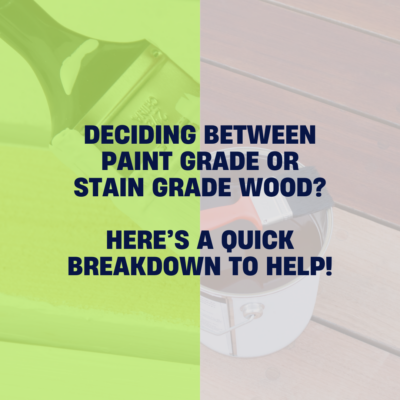Paint Grade vs. Stain Grade: Choosing the Right Wood Finish
When looking for architectural wood products such as balusters, columns, and newel posts for interior use, one of the many important decisions you’ll need to make is choosing between paint and stain grade wood. Both options have their own characteristics, depending on the style, function, and budget of your project.
In this guide, we’ll break down the key differences between both and help you decide which is the better fit for your next home improvement project.

Please note that the following pertains to interior applications. Exterior wood turnings are virtually always paint grade for protection of the wood, and in weather-resistant species of either Sapele or African Mahogany for optimal durability.
What is Paint Grade Wood?
Paint grade wood is specifically chosen for its ability to hold paint smoothly and uniformly. Often made from species such as poplar or soft maple, these woods are smooth grained and the least expensive of the hardwoods. While many softwoods, such as pine, are less expensive, knots and pitch can create problems in paint coverage over time and as such are typically avoided.
Best Uses for Paint Grade in Architectural Products
If your design calls for a monochromatic or vibrant color scheme, paint grade wood allows for flexibility in color choice without worrying about the natural grain. It’s ideal if you plan to match existing trim or wall colors.
What is Stain Grade Wood?
Stain grade wood, on the other hand, is selected for its beautiful, natural grain and color. Finishes can be clear coat for a natural appearance or stained to bring out more color and grain. Premium woods like red and white oak, cherry, mahogany, or walnut are typically used for stain grade applications. Because the goal is to enhance and highlight the wood’s natural grain and color, these woods are typically of higher selected quality and free of any cosmetic blemishes.
Best Uses for Stain Grade in Architectural Products
Stain grade wood is ideal for focal points. Whether you want to add warmth to a staircase or highlight the craftsmanship of your entryway, the rich tones of natural and stained wood will stand out beautifully. The natural grain patterns and tones can complement other wood elements in your home, making a statement of elegance and quality.
Key Differences Between Paint Grade and Stain Grade
Cost
- Paint Grade: Typically more affordable, since the species and quality of the grain is less important when it will be covered by paint. This can make it a better option for budget-conscious projects.
- Stain Grade: Higher-quality wood typically comes at a higher price due to the need for a near-flawless appearance that can be showcased by a stain or clear finish. These more attractive species of wood are also more expensive.
Maintenance and Longevity
- Paint Grade: While painted surfaces are durable, this format can be well suited for high traffic areas, as they can be restored to “like new”, with a fresh coat of paint.
- Stain Grade: Stained wood ages gracefully, often requiring less frequent maintenance.
Making the Right Choice for Your Project
Deciding between paint grade and stain grade can ultimately come down to the style and function of the architectural wood elements in your home or project.
Here are a few questions to consider
• Do you want to showcase the natural wood grain? Opt for stain grade.
• Is cost a concern? Paint grade may be more budget-friendly.
• Are you looking for bold colors or a uniform finish? Paint grade is probably your best bet.
Final Thoughts – Paint Grade vs. Stain Grade: Choosing the Right Wood Finish
Both paint grade and stain grade wood have their place in architectural design, and choosing the right one depends on your aesthetic goals and budget. Whether you’re choosing between balusters, columns, or newel posts, understanding the differences between these two wood grades will help you make an informed decision. This will ensure your finished project looks perfect for years to come.
Ready to begin working on a new project? Reach out to us today for a free, no-obligation estimate. Let’s get to work on the project of your dreams.

